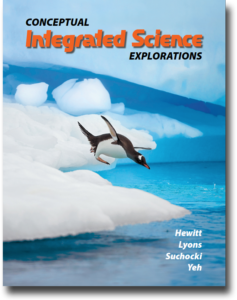
Integrated Science (Explorations)
An “integrated science” course serves the purpose of a “general science” course covering both the physical and life sciences. These courses are “integrated” in that the fields of science are not compartmentalized. Biology, for example, is discussed in the physics chapters and elsewhere as is appropriate. For example, in describing the physics concept of inertia, we show how this applies to the inner workings of our ears and our sense of balance. This pre-built course is useful for college level elementary education majors, as well as for younger students grades 7 – 9.
About Our Pre-Built Courses
We offer pre-built courses for all of our titles. A pre-built course works well when using Conceptual Academy much like the video version of a traditional textbook. Your students will have access to all the content listed within this pre-built course (see below). This provides flexibility from one semester to the next. For each semester you might direct students to be responsible for only select lessons or chapter sections.
Once a pre-built course is uploaded to your instructor’s account, you can modify it as you see fit to “make it your own”. This includes updating the FYI pages and setting dates for each lesson so that students know what to study by when. You can also remove select chapter sections you are not wanting students to see.
For a Conceptual Academy course aligned more precisely to a particular class schedule, we recommend you contact us to request a customized course. To learn more about customizing your course, please look to the help documents within your instructor profile page.
Integrated Science, CISE Explorations, The Full Textbook

Accompanying Printed Textbook: Conceptual Integrated Science Explorations, 1e. Sold separately
Review a .pdf of the front matter of this textbook, including its table of contents. Also, click here for a few sample pages from a chemistry chapter.
About This Course
This pre-built course collates all 39 chapters of the Conceptual Integrated Science Explorations textbook into 5 units and a total of 39 lessons (one lesson per chapter). With a greater number of shorter lessons, this “Explorations” course is a less rigorous version of Conceptual Integrated Science. There is ample material for two semesters of study. Along with a library of video tutorials and reading assignments, included are worksheets, interactive simulations, study advice from the authors, automated homework practice sessions, reading quizzes, and video quizzes with a grade book that tracks points, and unit exams.
5 Units; 39 Lessons
Unit A: Physics
Unit B: Chemistry
Unit C: Biology
Unit D: Earth Science
Unit E: Astronomy
Download this document to view Chapter Section details: PreBuiltCISEFull
About Laboratories
This Conceptual Integrated Science Explorations course is packed with ample laboratory activities, which are posted right within the weekly lessons. The materials for these activities, such as white glue, coins, and popsicle sticks, are readily available within your household or a discount store. This is important as it allows you to assign labs for various “homework” assignments. These lab activities are collated from a the following sources:
1) You’ll find the “Think and Do” activities described within the textbook end-of-chapter material. These activities tend to be short and sweet, as well as numerous.
2) We offer “PhET Labs” that make use of computer simulations created through the PhET program sponsored by the University of Colorado. The PhET simulations themselves are embedded within a lesson’s From Your Instructor (FYI) page. For many of these simulations you’ll also find within the Doc Share a write-up worksheet that guides the student through a simulation-based activity.
3) We offer the Conceptual Physics and Conceptual Chemistry Beyond the Laboratory Manuals created by professors Stephanie Blake of Ozarks Technical College, MO, and Brandon Burnett of Weber State University, UT. These creative manuals features many engaging and mind-opening hands-on experiments utilizing only readily available materials. For each activity, after following through a prescribed set of instructions (guided learning), the student is then pushed to create their own experimental procedure on a related subject (inquiry learning). The innovative yet safe activities of these manuals use only materials you’ll find within the home or a local discount store. With these manuals you can implement what we call the “flipped lab” where students conduct labs at home, which allows for critical follow-through to occur within class. You’ll find these manuals as free downloads on our labs page.
4) Our official Conceptual Integrated Science Explorations Lab Manual contains about 100 activities, which is way too much for any self-study course. So, in conjunction with the above mentioned activities, we have narrowed this down to 29 labs, which we have cut and pasted into documents made available to you through the FYI page of each lesson. Like the other lab activities listed above, these too require materials that should be readily available. For example, to measure a star’s ascension, you need only a straw, protractor, pencil, and a weighted string.
Sample Biology Video: Ecology

“Most of the scientific questions you’re curious about, or need to know, involve not just one discipline, but several of them in an overlapping way. What is the nature of the universe? That’s astronomy + physics. How are our bodies altered by the foods we eat? That’s chemistry + biology. What of our climate? That’s all of the above: physics, chemistry, biology, and Earth science!”
